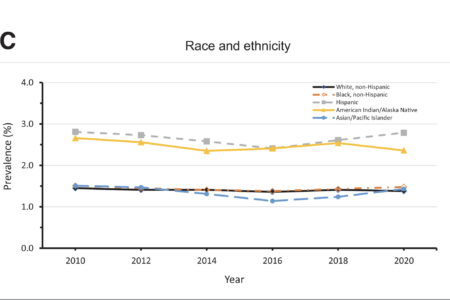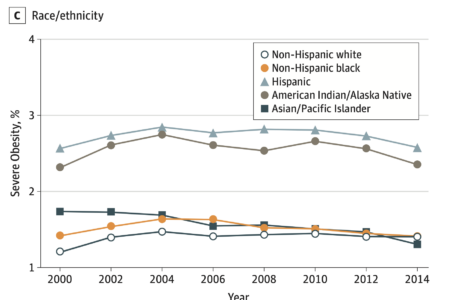
Share On Social!
Latino children accounted for the highest increase in severe obesity among preschool-aged children from low-income households, a new CDC study found.
The study examined children aged 2 to 4 under the enrollment of the Women, Infants and Children (WIC) program, which is a federal nutrition assistance program aimed at providing healthy foods for low-income women who are pregnant, breastfeeding, or postpartum, and children up to 5 years old, from 2010 to 2020.
When the study began in 2010, 2.1% of children aged 2 to 4 in WIC were severely obese.
A downward trend in severe obesity occurred for the next several years, when rates in that age group went from 2.1% in 2010 to 1.8% in 2016, the CDC study found.
However, by the start of the COVID-19 pandemic, that number spiked back up to 2% in 2020 – that’s about 33,000 out of the over 1.6 million children enrolled in WIC programs.

Latino children experienced one of the largest decreases during this time when rates dropped by .4% (from 2.81% to 2.41% severe obesity) before jumping back up .38% to reach 2.79% severe obesity in 2020.

The CDC study suggests that the initial decline in obesity from 2010 to 2016 may be attributed to 2009 revisions of WIC food packages, which allotted extra cash for fruits, vegetables, and whole grains while limiting spending on milk, cheese, and juice.
Revisions also included restrictions on milk fat content and added incentives to encourage breastfeeding.
Experts aren’t exactly sure what caused the obesity increase from 2016 to 2020.
“The daily hardships that families living in poverty are facing may be harder today than they were 10 years ago, and the slight increases in the WIC package just weren’t enough,” Dr. Sarah Armstrong, a Duke University childhood obesity researcher, told the AP.
It’s possible that state resources for low-income families, such as Medicaid and housing, along with funding for local WIC agencies and clinics, may have influenced the spike.
In addition, state policies and changes, such as healthier food and opportunities for physical activity in communities, accompanied by breastfeeding support, nutrition, and physical activity requirements in early care programs, may have been a factor.
The study didn’t incorporate data during COVID-19, which severely impacted children’s daily routines while limiting opportunities for physical activity and access to healthy food – two of the main components needed to control weight and support a healthy lifestyle.
“Ensuring that children and families from low-income households have access to early clinical detection, and referrals to effective and sustainable family-based interventions, could help promote healthy child growth,” according to the study authors.
Latinos and Obesity
Childhood obesity is at an epidemic level, affecting more than 14.5 million children and adolescents in the U.S. between 2017 and 2020, according to the Centers for Disease Control and Prevention.
Obesity is reported to be higher among children of color, impacting Latino children at 26.2% followed by black children at 24.8%.

Between 2013 to 2016, Latino children were found to be 1.8 times more likely to be obese than white children, according to the U.S. Department of Health and Human Services Office of Minority Health.
By the time Latino children reach high school, they are 50% more likely to be obese than whites.
Once obesity sets in it can be difficult to shake.
The study Predicting adult obesity from childhood obesity: a systematic review and meta-analysis, which was published in 2015, concluded that around 55% of individuals who are obese as children go on to be obese in adolescence.
Furthermore, 80% of obese adolescents remain obese throughout their adult, putting them at risk for severe health complications later in life.
Obesity has been cited as a common risk factor for both heart-related diseases and certain types of cancer, including liver and stomach, which are shown to have a higher prevalence among Latinos.
Targeting obesity at a younger age can significantly cut down on ailments, such as hypertension, and Type 2 diabetes, that lead to some of these diseases.
Establish Healthy Habits Where You Live
Depending on where you live, healthy food can be hard to come by.
Latinos and other minority families face systemic barriers to healthy food access.
A Salud America! research review noted that fast food restaurants and corner stores outnumber supermarkets and farmers’ markets in many Latino neighborhoods.
“This results in overconsumption of unhealthy foods, and more risk of obesity,” according to the research review.
For instance, did you know that there are 76.34 fast food restaurants for every 100,000 people in Bexar County, Texas (61.3% Latino)?
What does your neighborhood look like?
Find interesting facts and statistics about the inequities in your neighborhood by downloading a Salud America! Health Equity Report Card.
The Salud America! Health Equity Report Card gives you data and maps of the status of transportation, education, housing, healthcare, and other equity issues where you live compared to your state and the rest of the country.
Use this information to propose programs, initiatives, or policy changes that can build health equity – where everyone has a fair, just opportunity to be their healthiest – in your community.
GET YOUR HEALTH EQUITY REPORT CARD!
Explore More:
Latino ObesityBy The Numbers
142
Percent
Expected rise in Latino cancer cases in coming years



